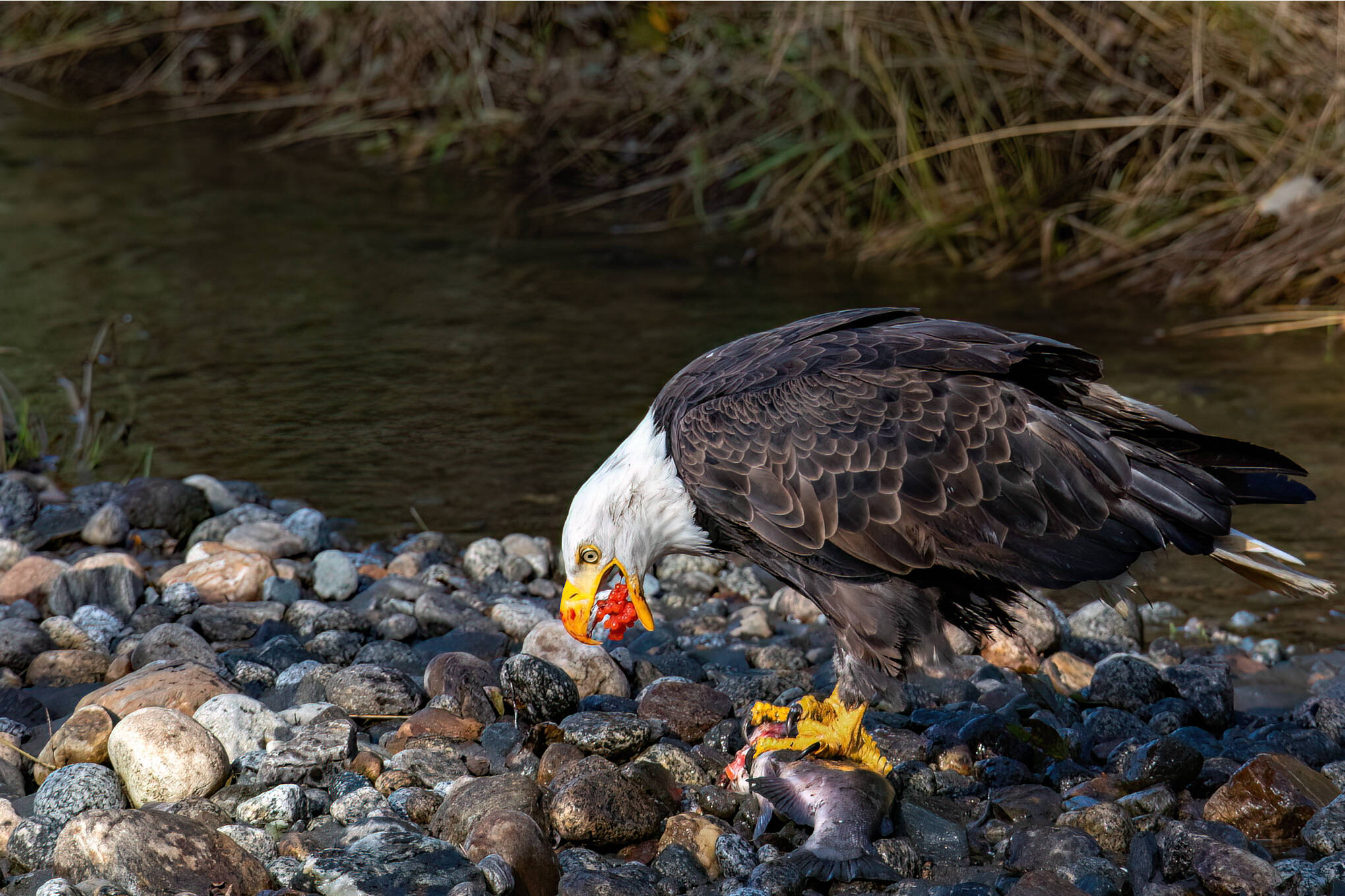A walk down the Boy Scout Camp Trail was notable for the near-absence of birds—no geese out in the big meadow, no gulls on or over the sandbars in the broad estuary, no eagles perched on stumps or trees, no ducks fiddling about in the shallow or resting on the sands. Very odd! On the way back to the car, we saw two or three gulls flying around and one eagle on a snag. Where is everybody?
The most interesting observations were the tracks in the sandy slough of a mama bear and a cub, who had wandered along there before heading over to the forest. Around the edges of the meadow, in several places, we found groups of dug-up lovage plants, leaving reddish stems behind — Bear-digs, for sure, maybe done by the track-makers. Strangely, we found no scat piles in any of these places.
We paused for a snack on the beach and, of course, the opportunistic ravens were there almost immediately. One was clearly dominant over the other, racing in to grab proffered bits and leaving the other one to complain in the background. Only rarely could the one in the background scoot around to grab a morsel.
Back at my home pond, a pair of female-plumaged mallards had been consorting all through September, occasionally joined by a third. (I assumed they were the same ones—they got very used to my daily disturbances at the bird feeders nearby). I was becoming convinced that they really were females, because I’d seen many males elsewhere in good breeding dress. But in early October, I began to notice subtle differences between the two regulars. Oooops! One of those girls is a guy! He’s just now starting to show a touch of green on the head and a shading of rusty color on his chest. This fellow is far behind many other males; maybe he is much younger? And will the other one eventually turn into a male also? A hint maybe came a few days later, when there were four males on the pond, all just beginning to show breeding plumage.
A break in the clouds and in the tourist traffic encouraged me to check out Steep Creek. The coho were in, and from the footbridge I watched a tattered female hover persistently over a stretch of gravel, probably guarding a nest. Off to one side, in a quiet pool, there were ten or so big fish, all lined up very close together and facing downstream. A couple of Dolly Vardens huddled with the coho for well over an hour. My companions suggested that they might be having a committee meeting, deciding what to do. That huddle was a puzzle—the eagle perched on the bridge railing was long gone, and so was a dog that splashed into the water on the other side of the creek. What was that huddle about?
Dippers were foraging on the lower creek and near the footbridge, swimming where necessary and wading in the shallows, poking occasionally at some potential prey. I was hoping to see them pick up some drifting salmon eggs, but no luck. They often snatch up loose eggs, such tasty bite-sized morsels. They aren’t the only ones to feast on them…Dollies hang out by spawning females and gobble up the eggs, and eagles eat them in gobs from captured female salmon.
A friend reported seeing varied thrushes and robins foraging on mountain ash berries, observing that the birds had stuffed themselves but then became uncommonly still. If the berries are now fermented, perhaps the birds were a bit drunk and not steady enough to fly. That often happens late in a warm season. Some decades ago, in late summer back in Illinois, people would bring robins and waxwings to my lab, thinking they were sick. So I’d put the invalids in big cages, give them ordinary food and water, and leave them in peace. By the next day, they had recovered from their alcoholic binge and were ready to head out the window for more. Bird-doctoring was easy in such cases.
That foraging observation triggered other thoughts too. The mountain ash berry crops are huge this year; the trees just droop with the weight of the ripe fruits. But several folks have commented to me that they don’t see the usual gangs of fruit-eating birds taking advantage of the bounty this year. And others have remarked that they just don’t see many small birds at all, in contrast to previous autumns. The fall weather has been unseasonably warm; perhaps there will be an influx of fruit-eaters later? There is a huge, worrisome decline in avian abundance in North America and elsewhere that’s been taking place over the years, and more and more species are at risk of extinction. Is the paucity of local autumn observations part of that general decline or some more idiosyncratic, regional trend?
Cottonwood trees near the lower part of the Perseverance Trail were nearly leafless, their branches beautifully emphasized by fog. Farther up the valley, smaller cottonwoods graced the hillsides with shining golden leaves. As the fog lifted, it left drops of water on leaves and twigs, and the coming sunshine picked them out as points of silver.
• Mary F. Willson is a retired professor of ecology. “On the Trails” appears every Wednesday in the Juneau Empire.

